 W
WThe coat of arms of Albany, New York, is the heraldic symbol representing the city of Albany, the capital of the U.S. state of New York. The coat of arms is rarely seen by itself; it is almost always used in the city seal or on the city flag. The current coat of arms was adopted in 1789, although prior to that it was significantly simpler, ranging from stylized lettering to a caricature of a beaver. Included in the coat of arms are references to Albany's agricultural and fur-trading past. It is supported by a white man and an American Indian and is crested by a sloop. The coat of arms is meant to represent the "symbols of industry and its rewards to man and beast on land and sea".
 W
WThe coat of arms of Barrow-in-Furness is the official symbol of Barrow Borough Council, the governing body of the Borough of Barrow-in-Furness, England. The arms were officially granted on 13 December 1867 to the County Borough of Barrow-in-Furness. Upon the amalgamation of the County Borough and adjacent Dalton-in-Furness Urban District on 16 April 1975 the arms were adopted by the Barrow Borough Council.
 W
WThe coat of arms of East Timor is one of the national symbols of East Timor.
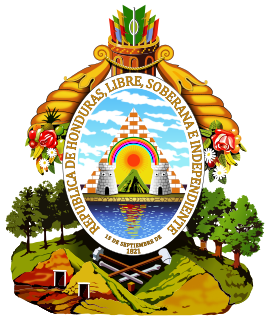 W
WThe coat of arms of Honduras is a national emblem of the Republic of Honduras.
 W
WThe coat of arms of the La Guajira was officially adopted by the Departmental Assembly Ordinance 028 of November 29, 1966 after the winning design of a public contest of pseudonymous contestant "Angel Cuervo". The coat of arms has subsequently been modified two occasions by the Ordinance 052 of 1994 and Ordinance 009 of March 10, 1998.
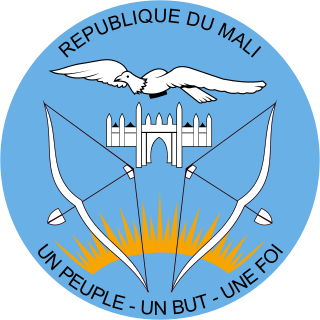 W
WThe coat of arms of Mali is a national emblem consisting of a circle charged with a bird at the top, a mosque in the centre flanked by two bows and arrows, and the rising sun at the bottom. Adopted thirteen years after the country gained independence, it has been the seal of the Republic of Mali since 1973. It is utilized on official documents as a coat of arms.
 W
WThe Great Seal of the Commonwealth of Massachusetts contains the coat of arms of Massachusetts. The coat of arms is encircled by the Latin text "Sigillum Reipublicæ Massachusettensis". The Massachusetts Constitution designates the form of government a "commonwealth," for which Respublica is the correct Latin term. The Seal uses as its central element the Coat of Arms of Massachusetts. An official emblem of the State, the Coat of Arms was adopted by the Legislature in 1775, and then reaffirmed by Governor John Hancock and his Council on December 13, 1780. The present rendition of the seal was drawn by resident-artist Edmund H. Garrett, and was adopted by the state in 1900. While the inscription around the seal is officially in Latin, a variant with "Commonwealth of Massachusetts" in English is also sometimes used.
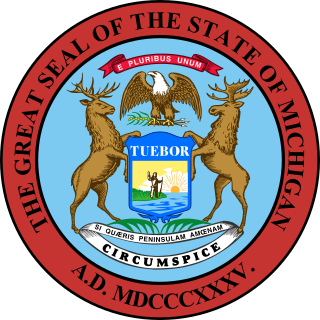 W
WThe Great Seal of the State of Michigan depicts the coat of arms of the U.S. state of Michigan on a light blue field. On the dark blue shield the Sun rises over a lake and peninsula, a man holding a long gun with a raised hand represents peace and the ability to defend his rights. The elk and moose are symbols of Michigan, while the bald eagle represents the United States.
 W
WThe coat of arms of Mississippi is an official symbol of the State of Mississippi.
 W
WThe Great Seal of the State of Mississippi was adopted in 2014, replacing a previous version that was used since the 19th century.
 W
WThe Great Seal of Missouri is used to authenticate certain documents issued by the Government of Missouri. The phrase is used both for the physical seal itself, which is kept by the secretary of state, and more generally for the design impressed upon it. The Great Seal was designed by Robert Wells of Jefferson City. Blazon: Per pale and to the dexter per fess, Azure a decrescent Argent, Gules a Bear passant facing to the sinister Argent, Argent a representation of the Coat of Arms of the United States proper.
 W
WThe emblem of New Caledonia consists of a nautilus shell in the foreground; the 2 symbols behind are a flèche faîtière, a kind of arrow which adorns the roofs of Kanak houses, thrust through tutut shells, and an Araucaria columnaris.
 W
WThe Great Seal of the State of New Mexico is the official seal of the U.S. State of New Mexico and was adopted in 1913.
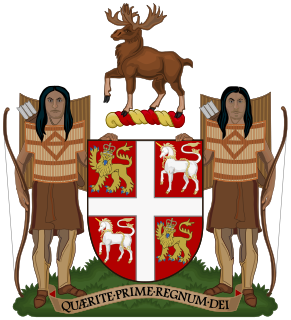 W
WThe coat of arms of the province of Newfoundland and Labrador was originally granted by Garter King of Arms, during the reign of King Charles I of England, on 1 January 1637/8.
 W
WThe coat of arms of North Dakota was created for use by the state government and National Guard units. An image of the coat of arms is seen on the flag of the Governor of North Dakota and a short discussion of its use can be found at the North Dakota state government website.
 W
WThe Great Seal of the State of North Dakota is the official seal of the U.S. state of North Dakota. The coloring added to the seal varies by source.
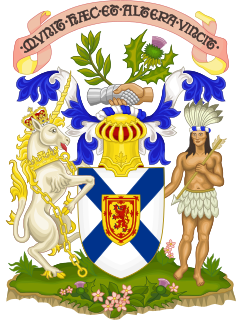 W
WThe coat of arms of Nova Scotia is the heraldic symbol representing the Canadian province of Nova Scotia. It is the oldest provincial achievement of arms in Canada, and the oldest British coat of arms in use outside Great Britain. It is blazoned as follows: Argent, a saltire azure charged with an escutcheon of the Royal Arms of Scotland.
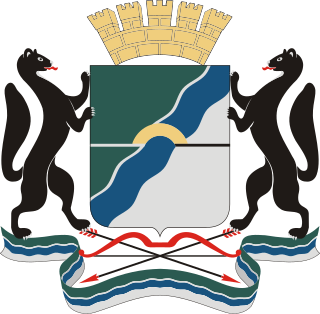 W
WThe coat of arms of Novosibirsk is the official heraldic arms of the city of Novosibirsk in Novosibirsk oblast in Russia. The coat of arms of the city were approved by the decision of the City Council of Novosibirsk from June 23, 2004 № 410 "On the emblem and flag of the city of Novosibirsk."
 W
WThe Great Seal of the State of Ohio is the official insignia of the U.S. state of Ohio. All governmental offices, agencies, and courts in Ohio use variations of the state seal. Its primary feature is a circular coat of arms that depicts a sunrise in Chillicothe, Ohio's first capital, along with symbols of the state's origins. The seal sometimes appears with the state motto, "With God, all things are possible".
 W
WThe Seal of the State of Oregon is the official seal of the U.S. state of Oregon. It was designed by Harvey Gordon in 1857, two years before Oregon was admitted to the Union. The seal was preceded by the Salmon Seal of the Provisional Government and the Seal of the Oregon Territory. The state seal is mandated by Article VI of the Oregon Constitution.
 W
WThe coat of arms of Ottawa was presented to the municipality of Ottawa by Vincent Massey on 20 October 1954.
 W
WThe coat of arms of the Philippines features the eight-rayed sun of the Philippines with each ray representing the eight provinces which were placed under martial law by Governor-General Ramón Blanco during the Philippine Revolution, and the three five-pointed stars representing the three major island groups of Luzon, the Visayas, and Mindanao.
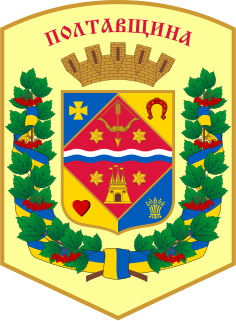 W
WThe Coat of arms of Poltava Oblast is the official coat of arms of Poltava Oblast.
 W
WThe coat of arms of the University of Sheffield is the official heraldic emblem of the University of Sheffield. It was granted by the College of Arms on 28 June 1905, one month after the university's royal charter was sealed. The coat of arms was registered as a trademark by the University of Sheffield in 1992. In 2005, the university designed a logo consisting of a simplified version of the arms; the logo, however, does not supersede the heraldic symbol.
 W
WThe coat of arms of Solomon Islands shows a shield which is framed by a crocodile and a shark. The motto is displayed under it, which reads "To Lead Is to Serve". Over the shield there is a helmet with decorations, crowned by a stylised sun.
 W
WThe Coat of arms of the Prince of Spain was set out in the Spanish Decree 814 of 22 April 1971, by which the Rules for Flags, Standards, Guidons, Banners, and Badges were adopted.
 W
WThe coat of arms of Suriname was adopted on November 25, 1975. The motto reads Justitia – Pietas – Fides. It consists of two indigenous men carrying a shield; a trade ship on the water representing Suriname's colonial past as a source of cash crops and its present day involvement in international commerce; the royal palm represents both the rainforest that covers two-thirds of the country and the country's involvement in agribusiness; the diamond represents the mining industry; the star symbolizes the five continents from which the inhabitants of Suriname immigrated.
 W
WThe National Emblem of Togo was adopted on 14 March 1962.
 W
WThe Great Seal of the State of Utah was adopted on April 3, 1896, at the first regular session of the Legislature. The original seal was designed by Harry Edwards & C. M. Jackson and cost $65.00, equivalent to $1,998 in 2019. The great seal is described in Utah Code Annotated, 1953, Volume 7a, section 67-2-9 as follows:"The Great Seal of the State of Utah shall be two and one-half inches in diameter, and of the following device; the center a shield and perched thereon an American Eagle with outstretching wings; the top of the shield pierced by six arrows crosswise; under the arrows the motto "INDUSTRY"; beneath the motto a beehive, on either side growing sego lilies; below the figures "1847"; on each side of the shield an American Flag.; encircling all, near the outer edge of the seal, beginning at the lower left-hand portion, the words, "THE GREAT SEAL OF THE STATE OF UTAH", with the figures "1896" at the base."